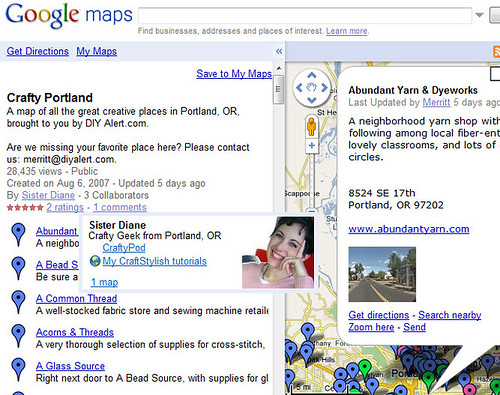When Google introduced their customizable maps feature two years ago, I thought to myself, “Cute, but who has time to be messing around creating special maps in most cases?” Now fast-forward to 2009 and I’ve turned into something of a technical evangelist for the feature, touting it at the SMX East conference last week and publishing an article today on Search Engine Land which highlights it as a long-tail marketing tactic for Google Maps.
The premise is fairly simple, although I see relatively few companies and individuals using the custom maps (“My Maps”) feature in Google Maps to help market their website or business.
Many users are generating custom maps, some of which garner tens or hundreds of thousands of views, depending upon how well they’re optimized and how much they target subjects of general interest. There are maps pinpointing crimes around cities, maps to find wifi locations, tourist points of interest, and maps showing where to go for certain types of shops or charitable organization donation dropoff locations.
Here’s one example of a entrepreneur leveraging My Maps effectively in Google:
The user, “Sister Diane”, has provided a very helpful map for people interested in her industry. The map shows stores where one may obtain various craft supplies all over the Portland, Oregon area. When one of her location listings is clicked, the information bubble that pops up on the Google Map contains a great description and address, and for some locations there are pictures, phone numbers and URLs.
She also filled out her Google Profile, so when her username is clicked or moused-over by the cursor pointer, map users can see her website URLs for her blog and another site where she writes articles.
This is a really good example of how developing and providing useful content within Google Maps can help to further promote your own content by exposing you to more consumers. While crafts in Portland is very much a small niche, Sister Diane’s map has achieved over 28,000 views since its creation two years ago.
Custom maps may be created by hand, using the simple tools for editing My Maps on Google. For larger lists of locations, I highly recommend creating a KML file as per Google Maps and Google Earth documentation, and either manually uploading the KML or submitting it via a geositemap from your website.
For more examples and tips on how to effectively leverage this long-tail marketing tactic, ready the full article at Search Engine Land, “Google Custom Maps: A Goldmine For Local Businesses“.









